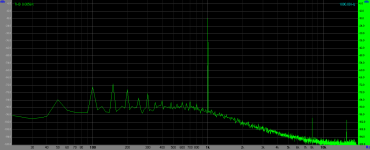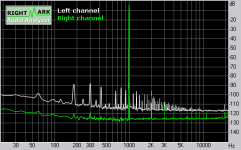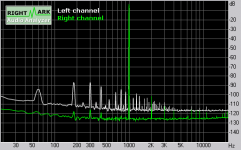No, it's not. With 20mV drop over 0.1R emitter resistor bias current will be 200mA. 20mV drop over 0.22Re bias current will be 91mA. Voltage drop over 0.22Re must be twice higher.Voltage drop across all Re must be between 18 and 20mV, regardless of resistor value.
This is Class AB amplifier. Recomended bias current for OP devices 150-200mA if I'm not wrong. However it could be raised much higher for the best distortion value, but heatsink has to be huge enough.
Last edited:
No, it's not. With 20mV drop over 0.1R emitter resistor bias current will be 200mA. 20mV drop over 0.22Re bias current will be 91mA. Voltage drop over 0.22Re must be twice higher.
This is Class AB amplifier. Recomended bias current for OP devices 150-200mA if I'm not wrong. However it could be raised much higher for the best distortion value, but heatsink has to be huge enough.
No one (that I could find in the thread) ever recommended modifications of voltage drop across Vre outside range 18-20mV, so I would avoid recommending it. Yes, that would obviously lead to change in Re current and therefore class A power, but I never claimed it wouldn't. My recommendations are based on proven statements in this thread, not my own opinion:
https://www.diyaudio.com/forums/sol...age-audio-power-amplifier-53.html#post1697928
RMI-FC100, a single stage audio power amplifier
Last edited:
Thank you guys!
So, if I do as recommended - 0.1R - 18-20mv, the amp will deliver Class A to a certain level (in one of the posts was mentioned several Watts) and after that level there will be class AB?
So, if I do as recommended - 0.1R - 18-20mv, the amp will deliver Class A to a certain level (in one of the posts was mentioned several Watts) and after that level there will be class AB?
Thank you guys!
So, if I do as recommended - 0.1R - 18-20mv, the amp will deliver Class A to a certain level (in one of the posts was mentioned several Watts) and after that level there will be class AB?
Yes🙂
This FFT seems strange. It looks like your noise under 1KHz is quite high which the 50Hz and it’s harmonics would be hearable since it shows 72-18= 54db (1W) at 150Hz...unless your measurement setup is picking noise not present in the amp itself....😕
Fab
Fab
Last edited:
This FFT seems strange. It looks like your noise under 1KHz is quite high which the 50Hz and it’s harmonics would be hearable since it shows 72-18= 54db (1W) at 150Hz...unless your measurement setup is picking noise not present in the amp itself....😕
Fab
That's correct, I was not able to competely get rid of it. See separate thread here:
Transformer HUM.
I guess the only remaining idea is to move to dual transformers as opposed to single toroid. My other amp which is built the same way has two transformers and no audible hum.
Last edited:
That's correct, I was not able to competely get rid of it. See separate thread here:
Transformer HUM.
I guess the only remaining idea is to move to dual transformers as opposed to single toroid. My other amp which is built the same way has two transformers and no audible hum.
Hi ZDR,
That result looks like it could be your computer causing a noise floor issue, I have been using ARTA with a laptop running from batteries.
I also noted that the measurement cabling, internal amp layout and environment can have a significant effect.
Even so, the THD number and harmonic distribution looks pretty good...
- Dan
Hi ZDR,
That result looks like it could be your computer causing a noise floor issue, I have been using ARTA with a laptop running from batteries.
I also noted that the measurement cabling, internal amp layout and environment can have a significant effect.
Even so, the THD number and harmonic distribution looks pretty good...
- Dan
I measured FocusRite alone, and it seems noise floor is quite low.
Attachments
Do you calibrate before measurement in ARTA?
Either way the amp looks good.
I usually do, but this is not Arta - it's Visual Analyzer🙂
- Home
- Amplifiers
- Solid State
- RMI-FC100, a single stage audio power amplifier





